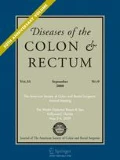Abstract
PURPOSE: Fecal incontinence may occur in several forms. Although some patients are grossly incontinent, other patients experience only leakage. In patients with gross incontinence, severity can range from the mildest forms (limited to loss of control of flatus) to the most severe forms (involving loss of solid stool). This study was undertaken to determine which physiologic parameters differentiate female patients with incontinence of solid stool from patients with control of formed stool and incontinence limited to seepage. METHODS: Thirty-eight consecutive female patients with a primary complaint of seepage or solid stool incontinence were evaluated using water perfusion manometry, balloon inflation assessment of rectal sensitivity, and pudendal nerve terminal motor latency. A prospectively maintained database was used for collection of data. The findings in the two patient groups were compared with patients in a group of normal control individuals. Ages of the women in the three groups were similar. RESULTS: Both groups of patients demonstrated statistically significant ( P < 0.05) decreases in rest and squeeze sphincter lengths, pressures, and pressure volumes compared with normal volunteers. The patients also had significantly more asymmetric high-pressure zones and hypersensitive rectums. No significant difference between the two groups of incontinent patients could be identified using any of these parameters. Significant differences between the groups were found in pudendal nerve function. The distal rectoanal excitatory reflex was abnormal in 58.1 percent of grossly incontinent women compared with 28.6 percent of patients with leakage ( P < 0.05). The majority of patients with leakage alone (65 percent) had normal pudendal nerve terminal motor latency, whereas only 22.6 percent of women with gross fecal incontinence had normal pudendal nerve terminal motor latency bilaterally ( P =0.01). CONCLUSIONS: Normal bilateral pudendal nerve function can partially compensate for abnormal sphincter symmetry and function, permitting women with grossly abnormal parameters to maintain control of bowel movements. It remains to be seen whether, with advancing age, patients with leakage will have development of slowed pudendal nerve conduction and, if so, whether their condition will progress to gross incontinence.
Similar content being viewed by others
References
Nelson R, Norton N, Cautley E, Furner S. Community-based prevalence of anal incontinence. JAMA 1995;274:559–61.
Talley NJ, O'Keefe EA, Zinsmeister AR, Melton LJ III. Prevalence of gastrointestinal symptoms in the elderly: a population-based study. Gastroenterology 1992;102:895–901.
Drossman DA, Sandler RS, Broom CM, McKee DC. Urgency and fecal soiling in people with bowel dysfunction. Dig Dis Sci 1986;31:1221–5.
Coller JA. Clinical application of anorectal manometry. Gastroenterol Clin North Am 1987;16:17–33.
Coller JA, Sangwan YP. Computerized anal sphincter manometry performance and analysis. In: Smith LE, ed. Practical guide to anorectal testing. 2nd ed. New York: Igaku-Shoin, 1995:51–100.
Sangwan YP, Coller JA, Schoetz DJ Jr, Murray JJ, Roberts PL. Latency measurement of rectoanal reflexes. Dis Colon Rectum 1995;38:1281–5.
Sangwan YP, Coller JA, Barrett RC, Murray JJ, Roberts PL, Schoetz DJ Jr. Distal rectoanal excitatory reflex: a reliable index of pudendal neuropathy? Dis Colon Rectum 1995;38:916–20.
Kiff ES, Swash M. Slowed conduction in the pudendal nerves in idiopathic (neurogenic) faecal incontinence. Br J Surg 1984;71:614–6.
Felt-Bersma RJ, Klinkenberg-Knol EC, Meuwissen SG. Anorectal function investigations in incontinent and continent patients: differences and discriminatory value. Dis Colon Rectum 1990;33:479–86.
Ferguson GH, Redford J, Barrett JA, Kiff ES. The appreciation of rectal distention in fecal incontinence. Dis Colon Rectum 1989;32:964–7.
Hoffmann BA, Timmcke AE, Gathright JB Jr, Hicks TC, Opelka FG, Beck DE. Fecal seepage and soiling: a problem of rectal sensation. Dis Colon Rectum 1995;38:746–8.
Hiltunen K-M. Anal manometric findings in patients with anal incontinence. Dis Colon Rectum 1985;28:925–8.
Read NW, Bartolo DC, Read MG. Differences in anal function in patients with incontinence to solids and in patients with incontinence to liquids. Br J Surg 1984;71:39–42.
Felt-Bersma RJ, Janssen JJ, Klinkenberg-Knol EC, Hoitsma HF, Meuwissen SG. Soiling: anorectal function and results of treatment. Int J Colorectal Dis 1989;4:37–40.
Sentovich SM, Rivela LJ, Blatchford GJ, Christensen MA, Thorson AG. Patterns of male fecal incontinence. Dis Colon Rectum 1995;38:281–5.
Rasmussen O, Christensen B, Sorensen M, Tetzschner T, Christiansen J. Rectal compliance in the assessment of patients with fecal incontinence. Dis Colon Rectum 1990;33:650–3.
Sun WM, Donnelly TC, Read NW. Utility of a combined test of anorectal manometry, electromyography, and sensation in determining the mechanism of idiopathic, faecal incontinence. Gut 1992;33:807–13.
Cheong DM, Vaccaro CA, Salanga VD, Wexner SD, Phillips RC, Hanson MR. Electrodiagnostic evaluation of fecal incontinence. Muscle Nerve 1995;18:612–9.
Vaccaro CA, Cheong DM, Wexner SD,et al. Pudendal neuropathy in evacuatory disorders. Dis Colon Rectum 1995;38:166–71.
Vernava AM III, Longo WE, Daniel GL. Pudendal neuropathy and the importance of EMG evaluation of fecal incontinence. Dis Colon Rectum 1993;36:23–7.
Hill J, Mumtaz A, Kiff ES. Pudendal neuropathy in patients with idiopathic faecal incontinence progresses with time. Br J Surg 1994;81:1494–5.
Author information
Authors and Affiliations
Additional information
Read at the meeting of the New England Society of Colon and Rectal Surgeons, Mystic, Connecticut, May 4 and 5, 1996.
About this article
Cite this article
Kafka, N.J., Coller, J.A., Barrett, R.C. et al. Pudendal neuropathy is the only parameter differentiating leakage from solid stool incontinence. Dis Colon Rectum 40, 1220–1227 (1997). https://doi.org/10.1007/BF02055168
Issue Date:
DOI: https://doi.org/10.1007/BF02055168




